Your gateway to East Africa



From Lake Victoria to the Indian Ocean, explore our top island hideaways
Olympic dream
Tanzanian swimming duo take on the world's best in Paris
Tale of the tower
Burj Zanzibar is set to break records and transform sustainable living on the island





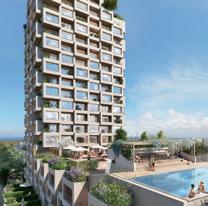
Explorer is published by: Land & Marine Publications (Tanzania) Limited 4th floor, Josam House, Block A, along Coca Cola Road, Mikocheni Area, Dar es Salaam T: +255 686 118 816
Editorial enquiries: markedwards@landmarine.com
Auric Air Services Limited Plot 154, Block 'B', Malaika Road, Ilemela, PO Box 336 Mwanza, Tanzania
www.facebook.com/auricair
www.instagram.com/auricair www.x.com/auricair auric-air-services-limited
Advertising sales: T: +44 (0)7714 448059 (WhatsApp) E: advertising@landmarine.com
Head Office: Land & Marine Publications Limited 6 The Square, Ipswich, Suffolk, IP5 3SL, UK
T: +44 (0)1206 752902
E: publishing@landmarine.com
Printed by Jamana Printers, Dar es Salaam.

Your gateway to East Africa
Welcome to Auric Air Services Limited‚ your gateway to unparalleled aviation experiences in East Africa. With a legacy spanning over two decades‚ Auric Air Services Limited has established itself as a premier air charter and scheduled flight operator in the region.
At Auric Air Services Limited‚ we understand that time is of the essence‚ and our commitment is to provide you with the most efficient‚ reliable‚ and comfortable air travel solutions. Whether you're embarking on a thrilling safari adventure‚ exploring remote destinations‚ or conducting vital business operations‚ our fleet of state-of-the-art aircraft and expert crew are dedicated to making your journey seamless and memorable.
As a leader in aviation‚ we offer a wide range of services tailored to meet your unique needs. From charter flights that cater to your specific schedule and destinations‚ to scheduled flights that connect you to the most captivating and remote corners of East Africa‚ Auric Air provides unparalleled accessibility and flexibility.
We adhere to the highest international safety standards to ensure your well-being throughout every flight. Our fleet consists of meticulously maintained aircraft‚ and our pilots undergo rigorous training‚ combining technical expertise with a deep knowledge of the local geography and weather conditions.
So, sit back and enjoy your flight. Your adventure is just beginning. Every flight with Auric Air is an opportunity to explore‚ discover‚ and create lasting memories.
Deepesh Gupta Director of Corporate Affairs


Auric Air continues to connect more of its passengers to their dream destinations.
The latest additions to our flexible service were introduced in July with an increased frequency of flights to Iringa, Mafia Island and Tanga from our Dar es Salaam hub.
The new flight series adds two afternoon flights between Dar and Iringa, a peaceful Southern Highlands town known for its agriculture and as a gateway to Ruaha National Park. The first leaves Dar at 2pm, arriving in Iringa at 3.30pm while the return flight leaves Iringa at 4pm to arrive in Dar by 5.30pm.
We now fly three times every day to the northern Tanzanian port Tanga with the addition of direct flights taking off from Dar at 11.30 am with a return flight leaving Tanga at 12.30pm.
Finally, we now offer three flights each day to the natural paradise of Mafia Island. The new 30-minute direct morning flights leave Dar at 9.30am with the return flight scheduled to head back from Mafia at 10.15 am.
Fly with Auric Air at a time and to a place that suits you. For more information on the new flights, head to auricair.com

Auric Air was hugely proud to receive the Africa’s Emerging Luxury Brand award at the Global Hospitality and Luxury Awards 2024. The awards event, which celebrates excellence in the African tourism industry, was held in Arusha in June.
Auric Air has long prided itself on providing a personalised and luxury touch to compliment the experience at popular safari camps. Our VIP charter flights alongside our growing fleet of aircraft, which now
include the latest Cessna Caravan and the market-leading DHC Dash 8-103 for larger groups, ensure a high level of comfort for our passengers.
Thanks to the Global Hospitality and Luxury Awards for recognising our work. The event is a prestigious part of the African hospitality calendar and it has become an integral part of the industry, celebrating achievements and setting benchmarks for excellence.


Auric Air can fly you to a host of unforgettable island getaways. From paradisal Indian Ocean archipelagos fringed by white sands and sapphire seas to wildlife-packed sanctuaries in Lake Victoria. Here’s our guide.



The one for enjoying Swahili culture in style…
also known as Zanzibar Island
This is very much the daddy of the Zanzibar archipelago’s holiday options: at 1,666 sq km it is bigger and brasher than the others and with a huge choice of luxury hospitality options to ensure you enjoy your island break in style.
Why?
High-end hospitality investment has hit the island in a big way so while there is no end of spectacular hotels to choose from, off-grid escapes are rare. Still the popular coastal areas of Paje in the south-east and Nungwi in the north still maintain a balance between sleepy fishing village and beach side resort. Inland, the Jozani Forest – Zanzibar’s only national park – is a great escape with walking trails and canoe trips through the mangrove swamps.
Must see:
Wandering Stone Town – the old port area of the capital city – is essential to soak up Swahili culture. While you’ll now find plenty of exclusive hotels, boutiques, restaurants and bars within its winding streets, the Unesco Heritage Site is still a living museum, showcasing ancient architecture and a way of life of life that have gone unchanged for centuries. Take in a taarab (traditional Swahili music) concert, explore the bustling markets and reflect on the port’s dark past at the Old Slave Market.

The one for an untouched island adventure…
About 80km northeast of Unguja, Pemba is the archipelago’s second largest island. Early Arab sailors called it ‘El Huthera’, meaning ‘The Green’, and it is still largely a fertile paradise of gently rolling hills, fragrant clove farms, lush forest and coral reefs teeming with marine life.
Pemba is a serene escape with the locals paying scant attention to what few tourists arrive and little to get in the way of whiling away your stay on its white sands with the occasional dip in the sapphire waters.
Tranquil as it is, Pemba’s natural treasures provide a wild playground for active visitors. Jump on bicycles to explore traditional villages and ancient ruins or take to the crystalline waters for swimming and kayaking. The Pemba channel is reputed to offer the best diving in East Africa with untouched coral reefs, bath warm water and superb visibility.
Must-see:
There was a time when Pemba was covered almost coast-to-coast in tropical forest. Now just a section remains, the Ngezi Nature Reserve, but its double-canopy denseness still presents a magical world to visitors where bird life abounds and vervet monkeys swing from vines. There are trails for guided tours with the longest reaching Vumawimbi Beach while night tours offer the chance to spot the forest’s endemic nocturnal denizens such as the Pemba scops owl and gigantic fruit bat, the Pemba flying fox.

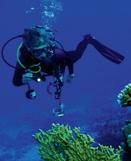
The one for unforgettable close-up encounters with whale sharks…
Kisiwa cha Mafia in Swahili
What?
The Mafia archipelago is made up of five islands –Jibondo, Juani, Chole, and Mafia. The latter is 160 km to the south of Unguja. Much of the southern stretch of its coastline is protected by the Mafia Island Marine Park, the largest protected area in the Indian Ocean and seasonal home to marine giants such as whale sharks.
Why?
Its pristine reefs and plankton-packed waters mean Mafia Island offers some of the best diving in the world. The season to swim with filter-feeding whale sharks here is the longest in the world with trade winds pushing a layer of plankton packed ocean water towards the island, encouraging the sharks to linger here from September to February. The waters here are also an excellent spot to watch humpback whales make their way up and down the coast as part of their annual migration. Add in incredible secluded beaches such as Ras Kisimani, just across from Bwejuu Island, and Utende Beach, which edges onto Chole Bay, and you have the perfect aquatic adventure holiday.
Must-see:
As well as being a marine-life magnet, Mafia Island has a deep cultural history. Like Unguja, has long been a crucial and cosmopolitan stop-off for Indian Ocean shipping routes. The remains of its trading heyday, dating back to the 13th Century, can be seen in ruins such as those at Kisimani Mafia – evidence of what is thought to be the earliest settlement on the island.

The one for an island animal safari…
Sequestered in the southwest reaches of Lake Victoria is Rubondo Island National Park, which provides a home for wildlife such as elephants, giraffes and hippos as well as a host of marine birds, including huge numbers of fish eagles and African grey parrots. The island also has many beautiful beaches to enjoy.
At 26 km long and 1§0 km wide, Rubondo Island is the largest island national park in Africa. It was gazetted in 1977 and animals such as chimpanzees, Roan and Suni antelope, rhino, elephant, giraffe and black and white colobus monkeys were introduced. The resident animals thrive in the tropical forest here, which still covers around 80 per cent of the island. To ensure the tropical ecosystem remains untouched, the island is uninhabited by humans. The Zinza tribe fishing community who once lived here and maintained banana plantations were resettled to surrounding islets or to the Tanzanian mainland. Strict fines and potential imprisonment are imposed for unauthorised landings and attempted poaching. There is a beachside camp on the island for overnight stays for tourists.
Rubondo provides one of Africa’s most remote and unique safari adventures. The island is fringed with soft, sandy beaches while the lush tropical forest is teeming with life, including over 300 bird species. Hang out in a hammock and dip in the swimming pool, or head out onto the water to enjoy bird watching or a catch-and-release fishing trip. In the evenings, savour drinks on the tranquil beach before hippos emerge from the water to feed after sunset.
Join a chimpanzee trek. When the primates were introduced on Rubondo half a century ago it was the first ever attempt to rehabilitate captive chimpanzees back into a wild environment. It has proved a huge success. Two troops of chimpanzee, totalling over 60 in number, now reside within the forest, making for an exciting tracking adventure through the dense forest.

Start your Auric Air Uganda adventure in Entebbe, home to the country’s international airport. While gorilla trekking in Bwindi National Park is the next move for many of our passengers, there is much to reward sticking around in this lush, low-key city on the northern shores of Lake Victoria. From bird-filled botanical gardens to island escapes, we select a few of our favourite Entebbe experiences.
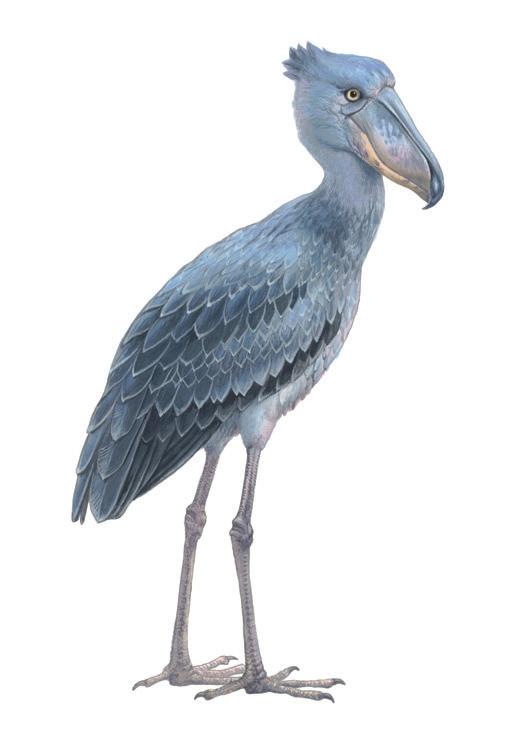
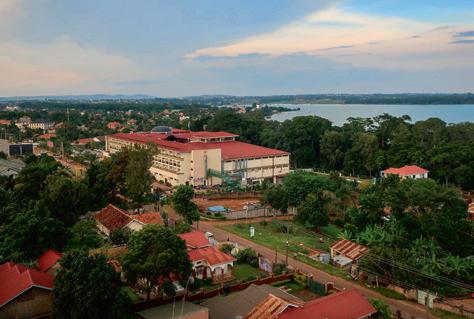

The shoebill is one of the great bird species of Africa and the swamps surrounding Entebbe are among the best places to see them in the wild. Using their massive beaks – which give the stork-like creatures their name and resemble a pair of deadly Dutch clogs – the birds feed on a wetlands bounty of eels, catfish, lizards and even small crocodiles. Bird watchers prize a sighting of this prehistoric-looking bird – the species does go back a long way, appearing in the artwork of the ancient Egyptians – and Mabamba Swamp, an hour from Entebbe by car or a 40-minute boat trip, is a prime spot. Growing up to 1.5 metres tall, the shoebill is hard to miss and draws attention to itself with its call – clattering that big bill to machine-gun-like effect.
Entebbe’s harbour offers opportunities to explore the islands of Lake Victoria. For one of Uganda’s most picturesque and tranquil escapes take the daily car ferry from Nakiwogo Dock – just south of Entebbe – to the Ssese Islands. This remote archipelago is a haven of white sand beaches, palm trees and lush forest. The ferry will drop you at Bugala, the largest and most developed of the islands – though this is all relative, you won’t find a car or paved road in sight – with its beachside lodges and bars. The island is a bird watcher’s paradise, and you’ll also find monkey-magnet forest as well as hippos and the sitatunga antelope in its wetlands. For more wildlife, you can take a boat to Ngamba Island (direct trips are also possible from Entebbe), which has become a Jane Goodall-endorsed sanctuary for orphaned chimpanzees in Uganda.



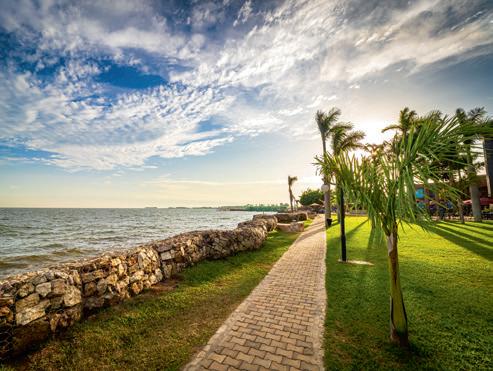

Visitors to Entebbe will be struck by its lush, green setting and the best place to soak up this verdant environment is its Botanical Gardens. It is a lovely spot for a calming walk amid ancient woodland that is home to colourful birds such as orange weavers, red-chested sunbirds and the African openbill stork. Legend has it that in the 1940s the rainforest here was used as the backdrop to the popular Tarzan films in the US, but now it is a variety of monkeys with their distinct calls that swing from the vines here.
Entebbe’s Lake Victoria coastline is peppered with hotel resorts with their own slice of the sandy beach. Many have their own beach bars such as the 2 Friends Beach Hotel, which has a terrace overlooking the lake to enjoy the perfect sundowner. A swim in Lake Victoria is not recommended with the occasional crocodile and hippo and the far more plentiful bilharzia parasite among the risks. However, 2 Friends like many other hotels here has an excellent pool for a cooling dip.
Craft hub Pearl African Village is a showcase of Ugandan artisan talent, both modern and traditional. Situated on the commercial thoroughfare of Portal Road, the complex is a great place to explore local art, fashion, home décor, musical instruments and coffee.
Entebbe is a great place to pick up a cheap rolex. No, not the handcrafted luxury watches, but a delicious Ugandan street food. The name comes from how it is created, which involves combining an omelette (usually with sliced vegetables) on top of a fried chapati, and then rolling it up. The result is ‘rolled eggs’, shortened to ‘rolex’. You’ll find plenty of vendors on Nsamizi Road who will cook this tasty snack right in front of you. They may also be serving ‘kikomando’, a popular variation on the rolex in which the chapati


Tanzania selected an eight-strong squad to compete at the pinnacle of world athletics, the Olympic Games. Among the last to know they would be heading to Paris as Olympians were swimmers Collins Saboko and Sophia Latiff who each received a wild card to compete. In exclusive interviews conducted ahead of their Paris trip, the pair –who both went on to break national records at the Games – speak about the moment they found out their Olympic dream would come true and how they hope their achievement will help promote the sport of swimming at home.
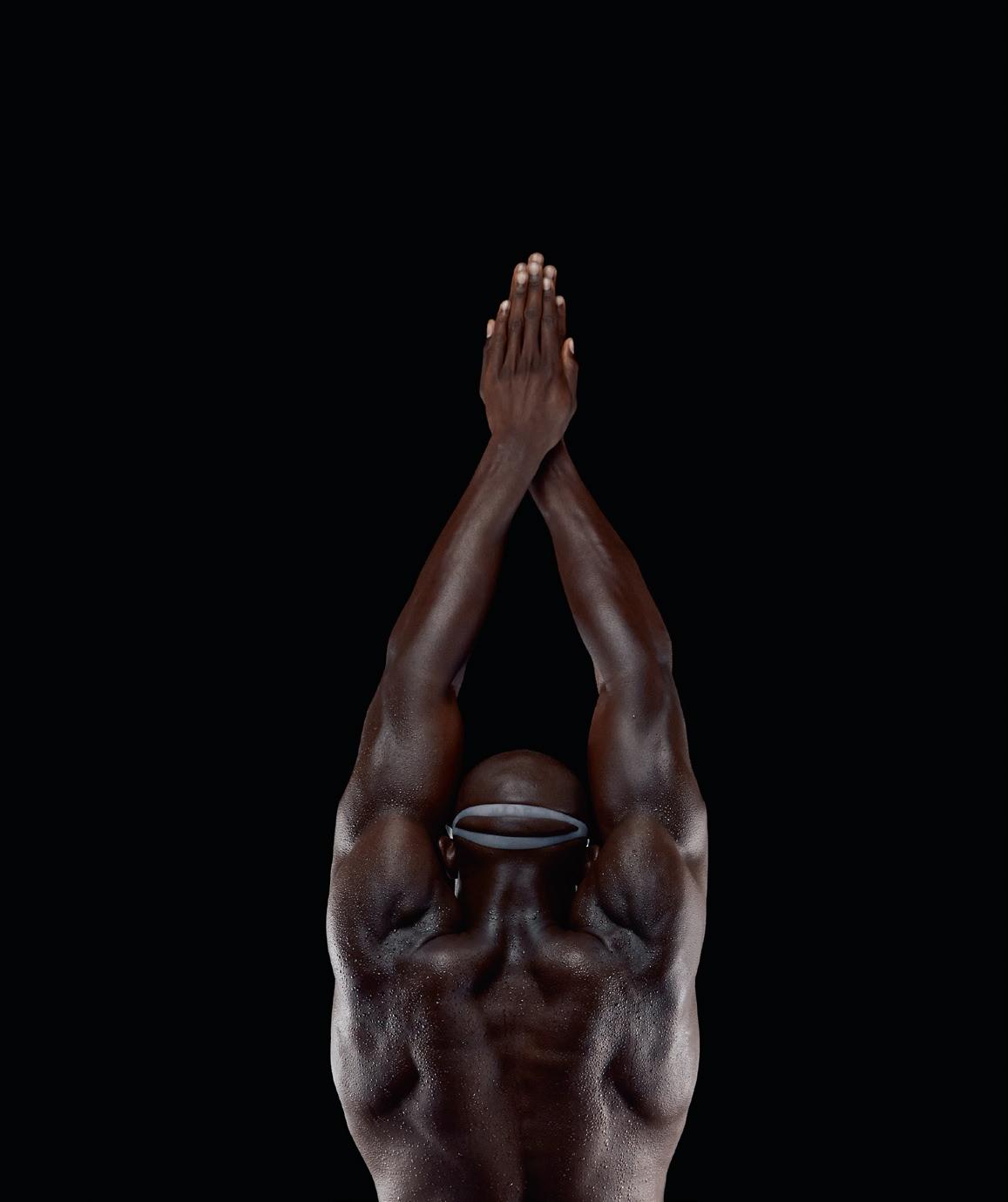



17-year-old Sophia excels in the sprint events and competed in the 50 metres women’s freestyle in Paris. The Dar es Salaam student learned to swim when she was three years old and has gone on to clock an impressive personal best of 27.82 seconds in the event – set at the IST Invitationals last year.
Where were you when you first heard the news that you have been selected for the Tanzanian team for the 2024 Olympics? What was your reaction?
I was on my way to training when I was called for a meeting by my head coach and secretary general of the Swimming Association. I was really excited and couldn’t wait to tell friends and family.
What are your hopes for the Olympics? Do you hope in competing against the world’s best it will push you to a personal best time?
I hope to achieve a personal best time and observe some of the world’s best swimmers to see how they perform. Realistically, I believe that competing against swimmers at my level will push me more to achieve my personal best results.
Have you been to Paris before? Will you have time to explore the city?
Yes, I went to Paris in 2019 and had an amazing time at Disneyland. Exploring the city would be fun but my focus will be on the race.
What are you most looking forward to about the Olympics?
Having the opportunity to represent my country. I’m also excited to be surrounded by so many cultures and make new friends.
You are part of an eight-strong Tanzanian team of athletes in Paris. How proud are you to be representing your country at the pinnacle of world sports? I will be overjoyed and will consider this as achieving one of my lifetime goals.
How old were you when you first started swimming? Why did you get into the sport?
I first learned how to swim when I was three years old. Then at the age of eight I started to compete in inter-school competitions. At 10 years old, I competed in my first international competition in Kenya. One of my swim coaches at the time told me I had potential and encouraged me to join a swim club to train more consistently.
Swimming is renowned for its tough training. Can you give us an idea of your swimming schedule? How many metres do you swim every day and what time do you get to the pool to start?
I train every day of the week except Sunday. I swim twice a day except on Wednesday and Saturday. I swim about 16 hours each week and do land training for three hours before some swim sessions during the week.
I usually swim between five and 10 kilometres every day. I get to the pool at 5am during school days and 6am during the holidays.
You specialise in the freestyle. What would be your tip to swimmers looking to improve their stroke? Kick, kick and kick some more! Most swimmers believe that the more strokes they make with their arms the faster they will go, but it is actually their kicking and the depth of their stroke that propels them forward.
What other athletes/events are you most excited to see in Paris?
In swimming, I am excited to watch the men’s 200metre freestyle, the 100 breaststroke and 50-metre freestyle. I am also eager to see the women’s 50 freestyle, 100 freestyle, 50 breast and the 400 freestyle. I’m looking forward to seeing [US women’s swim star] Simone Manuel and [French sprint specialist] Florent Manaudou.
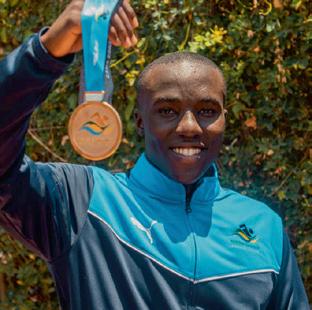
What effect do you hope you competing at the Olympics will have on growing the sport of swimming in Tanzania?
I hope to inspire the next generation of swimmers in Tanzania. I also hope to motivate the large percentage of Tanzanians who do not know how to swim –especially young girls – and encourage them to get involved in the sport.
What advice would you give Tanzanians who want to take their swimming to the next level?
They should open up @tanzaniaaquatics on Instagram and get in contact with the sportsmen and women and ask their advice.
Who is your swimming hero and why?
Simone Manuel because she is a black female in the sport, and she experienced similar challenges to me that I connect with.
What have been your proudest achievements in swimming so far?
Doing well in the World Junior Championships by coming first in my heat and creating new personal bests and winning the NSCA (National Sports Council Awards) Best Swimmer of the Year Award in 2022-2023.
Do you come from a sporting family?
My dad is a runner and has competed in marathons in the past. My grandfather was on the Zanzibar national swim team.
What has been your best race result so far?
My best race so far has been my 50 freestyle at the IST Invitationals 2023 in Dar es Salaam. I finished in a personal best time of 27.82 seconds.
The Mbeya-born Collins competed in the 100-metre freestyle event in Paris. Still only 22 years old, he has already proved himself on the international stage, winning through his heats in the freestyle and butterfly 100 metres events at the 2022 Commonwealth Games with a personal best time in each.
Where were you when you first heard the news that you have been selected for the Tanzanian team for the 2024 Olympics? What was your reaction?
I was at the International School of Tanganyika (IST) Masaki campus with my teammate Sophia Latiff when a member of our federation came with the good news. Hearing that we were confirmed to go, I was speechless. It was a sign of relief that all that hard work has finally paid off.
Do you hope that competing against the world’s top swimmers will push you to a personal best time?
I hope to get a personal best because that would be a personal highlight to beat my time on the biggest international stage in swimming
Have you been to Paris before? Will you have time to explore the city?
I have not been to Paris before but have spent over five hours waiting for a connecting flight at Charles de Gaulle Airport. I will have some time to explore the city after my races.
What are you most looking forward to about the Olympics?
The Olympic experience comes once every four years so my personal goals is to enjoy every single moment because not everyone gets a chance to be in the Olympics.
You are part of an eight-strong Tanzanian team of athletes in Paris. How proud are you to be representing your country at the pinnacle of world sports?
Just knowing that I am one of eight people going


“If you really want to improve in something even the small skills, have consistency until it becomes a habit”
to represent the country on the largest sporting platform is an achievement on its own. We are over 60 million people in Tanzania and yet only eight get to go.
Where did you grow up in Tanzania? Did your family encourage you to learn to swim at a young age.
I was born in Mbeya but I started swimming when we moved to Dar es Salaam. My dad knew how to swim and love taking my brothers and me to the beach so at some stage he was going to encourage us to learn to swim.
How old were you when you first started swimming? Why did you get into the sport?
I started swimming when I was about six or seven years old. At that time, it was a requirement for students to learn how to swim so I took it as a casual school activity. Luckily the school I attended also had swimming as an after-school activity, so I was fortunate enough to keep it up. At 12 years old, I moved to boarding school in England with a swimming scholarship to keep swimming and studying.
Swimming is renowned for its tough regimen of training. Can you give us an idea of your swimming schedule? How many metres do you swim every day?
I have a different schedule for each day. My favourite routine was swimming eight times and training out of the pool three times. I swim an average of 32,000 metres per week.
Butterfly is one of your specialties. It is widely regarded as the most difficult stroke to master. Why did you choose it and what do you like about it most?
I believe that strokes choose you. Yes, all strokes can be improved but you notice in an early stage which strokes works better for you. I kept on doing butterfly because after working on it with my coach for so long it became easy to swim that way for longer periods. I also kept swimming butterfly because I kept getting compliments of how smooth and effortless it looks when I do it.
What other athletes/events are you most excited to see in Paris?
I am a little bit of a swim nerd, so I have multiple events that I am excited to see. The men’s and women’s 100 free are commonly the favourites but I really want to see the 1,500 metres free world record go down.
What effect do you hope you competing at the Olympics will have on growing the sport of swimming in Tanzania?
Based on the previous Olympic games that Tanzanian swimmers have competed, there has been an improvement each time we compete. Therefore, I want to show that the sport is growing, and Tanzanian swimmers are improving.
What advice would you give Tanzanians who want to take their swimming to the next level?
A key piece of advice is to be consistent in training and everything. If you really want to improve in something even the small skills, have consistency until it becomes a habit.
What are your ambitions as a swimmer?
I want to have more swimmers qualify for big international swimming competitions.
Who is your swimming hero and why?
I don’t really have a swimming hero, but I enjoy watching most of the swimmers and learning from them. Not only from the way they swim but also the way the think and approach things.
What have been your proudest achievements in swimming so far?
Without a doubt Commonwealth Games Birmingham in 2022. It was my first time winning a heat in a major international competition (twice) and getting major personal bests in each event.

When booking your bucket-list hike up Mount Kilimanjaro it is important to bear in mind there are seven possible routes to the top. To help you make an informed choice on which one you should follow, experienced guide Josephat Mashehe breaks down the pros and cons of each.
AVERAGE LENGTH – 62 KM
ESTIMATED DIFFICULTY - HIGH
AVERAGE DURATION - 5 TO 7 DAYS
ACCOMMODATION - CAMPING
Almost half of people who take on Mount Kilimanjaro do so via the The Machame route – also known as the ‘Whiskey’ route. The scenery is excellent with four types of landscapes to pass through. This is a good route for dealing with altitude as many tours allow you to climb high and go back down to sleep low on the same days, allowing your body to better adjust to the elevation. Extra rest days are often available and if you have the time or money for this, it’s worth the investment to lower
the risk of altitude sickness and also physically prepare yourself for the summit climb.
The route can get crowded. Like all the camping routes on Kilimanjaro, porters will carry the tents. Walking days are longer on Machame than the other popular route, Marangu, and steeper, so it’s considered more challenging. This trail for Machame starts in the south before heading east under the southern ice field before the summit bid. You then descend on the Mweka route, which is used as a downhill-only path for many of the routes from the summit. There are two particularly difficult sections on this trek – an area before the Shira ridge, and the Barranco Wall –both of these are physically challenging and also may affect those with a fear of heights. Overall, though, this is a highly rated route with an excellent success rate and has some of the best scenery of all the routes. Just be prepared for it to be busy!
AVERAGE LENGTH – 72 KM
ESTIMATED DIFFICULTY - MEDIUM
AVERAGE DURATION - 5 TO 6 DAYS
ACCOMMODATION - HUT DORMITORIES
The oldest and the second most popular trail is the Marangu Route, or the ‘Coca-Cola’ route – so called because porters used to bring bottles of the soft drink to the various huts along the trail. Around 40 per cent of all visitors take this trail so it is one of the busiest. It is the preferred route for more casual and inexperienced trekkers as it is considered the easiest of the Mount Kilimanjaro hiking options. However, this also contributes to it having the lowest success rates –which is usually attributed to people underestimating its difficulty and the route’s extreme altitude changes. Many tours offer an extra day to do this route to combat the risk of altitude sickness and it’s definitely worth investing in that to maximise your chances of resisting the effects of altitude.
The other reason this route is so popular is that the Marangu route is the only one to offer hut accommodation along Kilimanjaro for its entire length. Trekkers sleep in dorms with mattresses and other basic amenities, although there is no electricity. Usually, you can buy snacks and drinks at the huts as well. The Marangu route departs from the south-east of Kilimanjaro and reaches Uhuru Peak (the summit) via Gilman’s Point. It is also the only route to use the same trail on the descent, so in terms of scenery variation over time it’s probably the weakest option, however, the views that you do get are great, especially from the Saddle. This is a good route if you’re short on time or do not want to camp.
AVERAGE LENGTH – 73 KM
ESTIMATED DIFFICULTY - MEDIUM
AVERAGE DURATION - 6 TO 7 DAYS
ACCOMMODATION - CAMPING, EXCEPT FINAL NIGHT IN HUT
Popular with more expensive tours and much quieter than the main routes, the Rongai route travels along a more isolated part of the mountain and starts off much more easily than the other treks.
Accommodation is camping only, except for the last night which usually finishes in a hut. Rongai is unique in that it’s the only trail which approaches Kilimanjaro from the north, which as well as giving you a different perspective on the mountain, also allows for clearer views of the peak. The highlight aside from the summit are the first few days in which you’ll pass through unspoiled wilderness and alpine desert near the Kenyan border, with plenty of wildlife spotting opportunities, although after that, the scenery is less varied than other routes. Many trekkers coming in from Kenya prefer this route.
This is one of the easier trekking options for Mount Kilimanjaro with flatter gradients than the other routes, however, there’s less opportunity for acclimatisation and the northern approach summit day is one of the toughest. A good option for less-experienced trekkers who want to get away from the busy Marangu route, and for those who want a slightly more sedate and chilled version of the trek!
AVERAGE LENGTH – 70 KM
ESTIMATED DIFFICULTY - HIGH
AVERAGE DURATION - 6 TO 8 DAYS
ACCOMMODATION - CAMPING
The Lemosho route is an exceedingly scenic route that starts to the west of Mount Kilimanjaro before joining the Southern Circuit, and then varies depending on the tour, with some joining the Machame route and others going onto the Northern Circuit. Typically, it descends via the Mweka trail. It is another very quiet trail and has camping only, making it a great way to get away from the crowds, however, it is one of the tougher routes of Kilimanjaro. The rewards are excellent though, with amazing scenery, including a nice heath section. Lemosho is also one of the best routes for acclimatisation with high summit success rates.
Like the Rongai route, the start is in a scenic, remote area giving the opportunity to see wildlife and it also offers great views of the dramatic gorges which lie on Kilimanjaro’s western side. Another bonus is the chance to hike over the Shira Plateau, one of the highest in the world. It’s also a peaceful route which only gets busier when it joins the more popular trails. Bear in mind that Lemosho is not usually recommended during the rainy season as the start point can become inaccessible.

“Lemosho is also one of the best routes for acclimatisation with high summit success rates”

AVERAGE LENGTH – 56 KM
ESTIMATED DIFFICULTY - HIGH
AVERAGE DURATION - 6 TO 7 DAYS
ACCOMMODATION - CAMPING
The Shira route is actually the original version of the Lemosho route. It starts at a much higher altitude with travellers transported to 3,600 metres at Shira Gate and on day two merging with the Lemosho route. For this reason, it’s usually only offered to trekkers who have already acclimatised to high altitudes and can be dangerous to those who haven’t. The advantages are that it’s a day quicker than the Lemosho route, and the drive up is spectacular.

AVERAGE LENGTH – 98 KM
ESTIMATED DIFFICULTY - HIGH
AVERAGE DURATION - 9 TO 10 DAYS
ACCOMMODATION - CAMPING
The newest route on Mount Kilimanjaro is another very quiet trail and the longest hike available. It has very high success rates as the length of the trip gives lots of opportunity for acclimatisation. This trek starts on the Lemosho route but after a few days strikes out on its own, traversing the deserted northern slopes of Kilimanjaro with spectacular scenery – and offering views that you won’t get on the other routes.
Thanks to its length the Northern Circuit has very varied scenery and goes nearly all the way around Kilimanjaro. So, this is one of the best, however, it’s also generally the most expensive tour as it’s so long. You’ll also need to be prepared for the endurance required for the extra days hiking and camping.

JANUARY AND FEBRUARY
January and February are great times to climb Kilimanjaro. The weather is relatively warm, and visibility is good. However, it is a busy time on the mountain.
March to May is the long rainy season. There are very few people on the mountain, but the trail conditions can be very muddy, wet and snowy.
June is a transitional period that is characterised by low visibility and cold temperatures. It is considered the start of the climbing season.
July to October is the busiest period on the mountain. It is dry but the temperatures are relatively cold. Visibility is great.
November is the short rainy season. Precipitation is moderate compared to the long rainy season. Few visitors climb Kilimanjaro during the month.
December is a crowded time due to the holiday season. But the short rainy season often runs into this month.
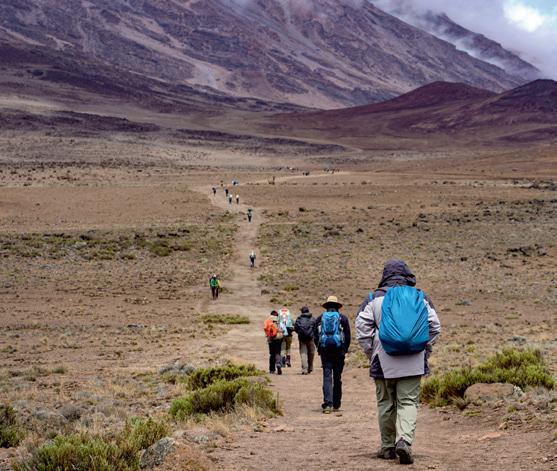

Choosing the right guide can make all the difference in ensuring a safe, successful, and unforgettable climb. Josephat has over 15 years of experience climbing and guiding Mount Kilimanjaro and has successfully led over 500 climbers to the summit. He is certified by the
AVERAGE LENGTH – 53 KM
ESTIMATED DIFFICULTY - VERY HIGH
AVERAGE DURATION - 5 TO 7 DAYS
ACCOMMODATION - CAMPING
Probably having the least foot traffic of all the routes, the Umbwe route is perfect for those wanting to get away from it all. This is a fast and direct route for experienced trekkers, being the hardest of the main trails with the steepest climbs. Its sharp altitude changes are reflected by its lower success rates. You should only consider the Umbwe route if you are confident at high altitudes or have pre-acclimatised. In return, you’ll get the quietest trip of all, with stunning ridges and some of the best views of any route. This route starts to the southwest of Kilimanjaro and climbs steeply, before usually connecting to the Southern Circuit before summitting. Umbwe is also well known for its many caves which can be visited during the trek.
Although it’s no longer a main Kilimanjaro route, it would be remiss not to mention the Western Breach. This is a dangerous route and is not offered by most tour operators for this reason. In 2006 the route was temporarily closed when a rockfall killed three unfortunate trekkers. This is a steep route with poor acclimatisation and despite changes to the trail and route since re-opening, it still has hazards which make it too unsafe for most. This is a route for very experienced trekkers and climbers and technically difficult. It is still possible to do this route through some operators, who generally make you agree that it is at your own risk.
Kilimanjaro National Park Authority (KINAPA) as an official guide. Josephat speaks English fluently in addition to Swahili and other local languages. He also provides thoroughly checked equipment for climbers who need it and meticulously checks their condition
daily to maximize safety. Josephat is among the guides at Mount Kilimanjaro Guide. Find out more at mountkilimanjaro.guide or email mountkilimanjaro@gmail.com
For more details on Josephat, head to his Instagram @josephatmashese

Lake Manyara National Park might be one of the smallest reserves in Tanzania, but it packs a lot in with its array of habitats offering refuge to plentiful animal and bird life. Explorer takes a closer look at this hidden gem.
Here’s a question for you. What do Queen Elizabeth National Park in Uganda as well as the Lake Manyara, Tarangire and Serengeti national parks in Tanzania have in common? They are each home to populations of tree-climbing lions in their forested areas. Scientists don’t believe the limber lions in Lake Manyara are any different genetically to the ground-dwelling majority, they have just shown a bit more initiative. The high life has its benefits. Sprawled cosily across the high branches they the lions can spot prey below as well as escape bothersome heat and flies.
The presence of tree-dwelling lions in Lake Manyara’s acacia forest adds to the thrill of navigating one of the park’s premier man-made tourism attractions: the tree-top walkway. Actually, lions prefer to steer clear of human traffic so guided tours of the 18-metre-high, 370-metre-long boardwalk are more likely to reveal blue, vervet, and Manyara monkeys along with plenty of birds and butterflies. The walkway begins at the Visitor Centre by the ‘Old Gate’ entrance to the park.
As you can imagine, Lake Manyara – the seventh largest Tanzanian lake by surface area – dominates one of the country’s smallest national parks. During the wet seasons (November to December and March to May) the lake itself can cover up to 60 per cent of the park’s total area – a vast 231 sq km. During these months, the lake’s salty, alkaline waters attract a variety of migratory waterbirds, including huge flocks of pink flamingos as well as pelicans, yellow-beaked storks and cormorants. At its flooded peak, the lake and its ponds and tributaries are home to more than 380 species of bird.

The lake is almost unrecognisable during the dry season, shrinking to such an extent that visitors can circumnavigate it with ease. Rains are unreliable here, but even in the most parched periods the park can sustain thick rainforests, wetlands, and acacia forests as well as savannah. How? They are nurtured by a permanent supply of ground water from the crater highlands directly above the Manyara basin. This mosaic of diverse habitats offers refuge to a wide variety of wildlife. Primates proliferate in the evergreen forest while elephant, zebra and impala enjoy the many watering holes across the grassland between forest and lake and hippos stay submerged during the day in natural pools. Best of all, the park is small enough that visitors can take in all these ecosystems in one day.
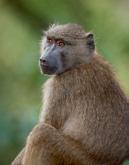
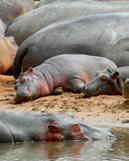



“Sprawled cosily across the high branches they the lions can spot prey below as well as escape bothersome heat and flies”

Elephants are synonymous with Laka Manyara and there are plenty of large herds to spot on your safari. Still, numbers today are only a fraction of what they were less than a century ago when it was estimated seven elephants roamed each square mile of the park – one of the highest densities in Africa. The reason for the dramatic fall in numbers was due to decades of criminal hunting. Now the callous practice has been outlawed in the protected park and numbers are increasing once again.
Lake Manyara National Park is hippo heaven. There are pools and hot springs for the hippos to stay submerged in throughout the day to protect their surprisingly sensitive skin from the sun’s rays as well as plenty of marshland providing rich feeding grounds. The biggest hippo hangout is located on the northern shores of Lake Manyara in Tanzania where it meets the Simba River delta. There are guided canoe trips on the Lake that allow you to observe these highly territorial giants from a safe distance.
While Lake Manyara National Park’s wealth of monkeys keep to the comfort zone of the forested areas, its baboons roam around like they own the place. The park has the largest concentration of baboons in the world, and you’ll see them in hundreds-strong groups – with super cute infants hitching a ride on parents’ backs – gambolling along the roads and paths here.
Why the size and structure of Burj Zanzibar – set to be the world tallest timber tower in the world –could be the secret to the island’s sustainable success.



The Fumba Peninsula is a 14km by 3km promontory south of Zanzibar’s capital flanked on both sides by pristine coastline.
Sebastian Dietzold compares it in size and shape to the island of Manhattan in New York.
The urbanisation of Fumba over the past decade –overseen by the German-led engineering firm CPS Dietzold founded with wife – has advanced the similarity. Launched in 2015, Fumba Town is Zanzibar’s first eco city with already over a thousand state-ofthe-art apartments and villas housing a cosmopolitan community supported by on-site schools, universities, shops, health centres and even an organic food delivery service.
If Fumba Town is Zanzibar’s Manhattan, then the Burj Tower looks set to be its Empire State Building. At 96 metres in height, the 27-storey timber tower will be an iconic addition to the Fumba skyline. Dietzold describes the development – which will include a Canopy by Hilton luxury hotel on the first six floors, topped by 187 sea-view apartments and top-notch amenities throughout – as Fumba Town’s “flagship building”.
Currently all that exists are some mouth-watering artist’s impressions of the tower – including its ultra-luxury penthouse suites with roof gardens and spectacular public spaces such as the roof bar, pool and gym – with the ground-breaking ceremony scheduled to take place early next year and completion anticipated in 2028.
Potential record-breaker
Already the building’s headlining height has attracted global media attention. If Burj Zanzibar was built today it would be the tallest timber tower in the world.
The scale of the Burj and the natural materials used to build it are integral to the Dietzolds’ vision for sustainable urban development in Zanzibar and beyond.
“The tower will be our landmark,” Dietzold says. Not because it’s a glamorous highlight but because it will promote responsible, sustainable buildings and trigger a whole new industry in Tanzania, from agroforestry to the production of engineered wood products.”
“The Burj Zanzibar tower is part of our mission to meet the massive housing demands in Africa in a

responsible way. We want to support a technology that protects our planet.”
Tanzania has one of the fastest rates of population growth in the world with the number of citizens projected to reach 100 million by 2035. That’s more than a 50 per cent rise on the current figure. When working with mother nature, Dietzold believes high rise buildings can be the answer.
“60,000-plus new homes are needed in Zanzibar Town over the next 15 years,” he says. “Space is limited on Zanzibar. We have to go up.”
The Zanzibar government is aware of the housing shortage and gave permission to CPS to create an inclusive urban development. Across its 149-acre site that fringes 1.5km of coastline, Fumba Town is already more than a third of the way towards building 3,000 units with the emphasis of the last stage of development – known as Phase 3 – on more high-rise properties with Burj Zanzibar at the pinnacle.
“Fumba Town has been designed for two to three million people in the long run,” Dietzold says. “Phase 1 began with two-storey buildings, now there are three-storey and four-storey buildings. Phase 3 will be predominantly high-rise and will give the development more of a city character.”
Wood is the material of the future
As well as the raised height of its new buildings, Fumba Town is featuring increased use of cross-laminated timber (CLT). Dietzold describes it as “the concrete of the future” and is so sold on its benefits that when we connect on Google Meet for this interview, he appears on my screen from the office of his timber-built villa in Fumba Town where he lives with his family. “We feel like this is home now,” he says.

CLT is an engineered product consisting of layers of wood boards stacked in alternating directions and glued together. The result is a solid, durable panel that has the load-bearing qualities of concrete, without its heavy carbon footprint. Conventional concrete construction is responsible for around a quarter of global CO² emissions while CLT absorbs carbon during the building’s lifetime.
From construction to production
Measures that can stem the march of climate change on the fragile ecosystem of Zanzibar Island are crucial. Building a sustainable future here is a goal shared by CPS and the Zanzibar government. Currently, the wood is sourced from Austrian spruce forests and fabricated as CLT panels in the same country by Binderholz, a global leader in timber construction.
The panels are then shipped to Zanzibar where they are kitted together Lego-like by local construction company Volks.house. Dietzold is proud that the 160-strong Volks.house team is predominantly made up of neighbouring villagers trained to assemble the timber-based homes in super quick time.
“We have moved from construction to production,” he says. “Our mass-made timber homes are an important development if we are to keep up with demand.”

The team’s work is so finely tuned now that its latest project, the three-storey timber homes that make up Fumba Town’s new Vizazi collection, was completed in just seven weeks earlier this year.
“We have around eight years’ experience with timber homes,” says Dietzold. “Our team is becoming
internationally recognised for its expertise. We have had recent requests from German buyers wanting to make use of our workforce.”
These smaller projects are priming the team for the big one: Burj Zanzibar. The design by OMT architects features timber columns and beams as well as cross laminated timber slabs to form the tower’s honeycomb-like outer structure. This will be built around a steel-reinforced concrete tube at its centre.
The inclusion of conventional materials at the building’s core is to ensure all required fire and life safety standards are met. While there are all-timber towers in Norway – including the 85.4-metre-high current record holder in Mjøstårnet – and Switzerland, they are not permitted in Zanzibar.
While he accepts the ruling, Dietzold points out that CLT is renowned for its inherent fire resistance.
“It’s funny that people think timber is more combustible, but it is the opposite. Engineered timber structures are safer than concrete – we know how they react under fire. We have been working with [fire safety service] Ingnis running thousands of fire
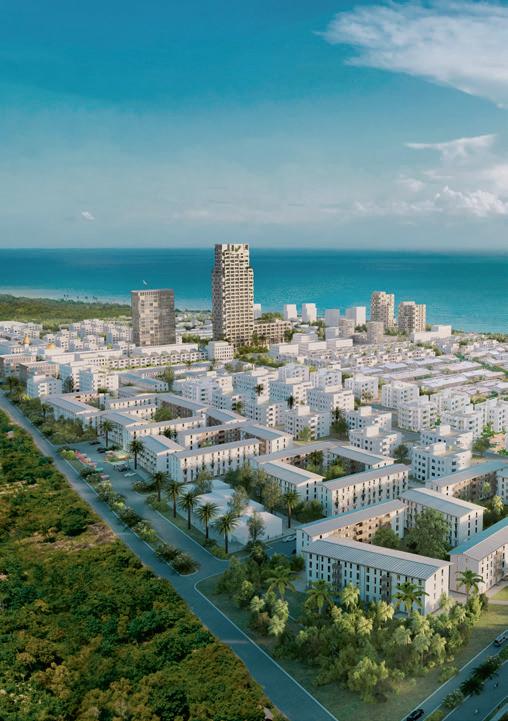
“Our mass-made timber homes are an important development if we are to keep up with demand”
tests. If you heat timber walls to 1,200º they just crust and that crust is a heat insulator – the temperature doesn’t rise more than 10 degrees inside.”
Dietzold adds that CLT remains structurally stable when subjected to high temperatures and – fond as he is of a Big Apple-analogy – he references one of the most tragic moments in New York’s modern history to power his point: “If the World Trade Centre was a timber construct it would not have crashed to the ground.”
The chance to own a part of such an iconic building and to enjoy elevated living has meant apartments in Burj Zanzibar are selling fast. Dietzold says over half of them have already been snapped up. As with the rest of the Fumba Town development, buyers and investors have proven to be a cosmopolitan crowd. “We have had buyers from around 60 countries, including the US and UK” Dietzold says. “Many are Africans. Zanzibar is a safe haven on the continent and now you can get residency for US$ 100,000.”
The majority, though, are Tanzanians with Dietzold saying it was always in the CPS plans to target the country’s rising middle class with their pricing.

Apartments in Fumba Town start at just under US$ 38,000 while you can get a studio in Burj Zanzibar from US$ 108,442.
The influx of these young professionals is helping to build a vibrant culture in Fumba Town. The fine homes are attracting fine minds. Last year the Indian Institute of Technology opened its first international branch in Fumba while the eco city is also home to the African School of Economics, which has 5,000 students.
“There is a culture of innovation growing. Fumba is transforming. We are trying to make a change here,” says Dietzold. The Burj is a symbol of that change, but I ask Dietzold whether any of the early Fumba Town residents are concerned that their homes will soon be in the shadow of a gigantic neighbour.
“There has been some criticism, but most people are excited,” he replies. “Everybody who bought into Fumba knew this was growing community and it would evolve over time. The Burj is already attracting investment and all Fumba homes are appreciating in value as a result.”
With residents onboard with the changes charted for Fumba Town, the city moves forward with the sustainable future of Zanzibar at its heart.
Construction of the Burj will require a huge increase in timber, which CPS is hopeful it can begin to source from Tanzanian forests. “It will simulate a lot of investment in the Tanzanian timber industry,” says Dietzold. “Tanzania has huge pine forests in the south. Pine is fast-growing so you can sustain the lumber stock for a long time and create a circular supply chain.”
The CPS website singles out a forest development in central Tanzania near Iringa. Its size? Twice that of New York.

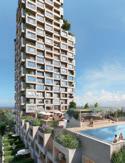
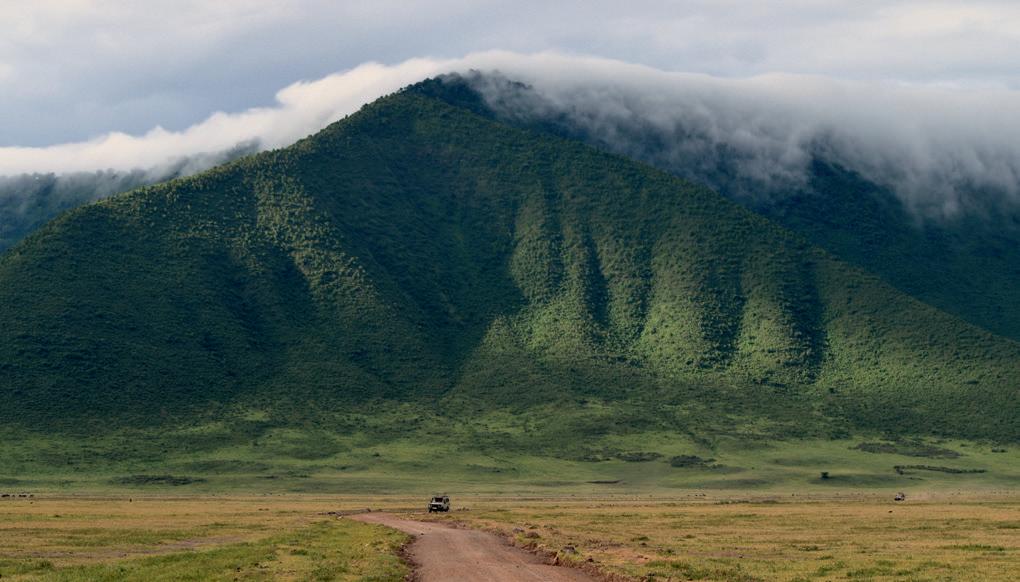
Auric Air has proved itself a pioneer among the local aviation industry through its eco-friendly initiatives to limit carbon emissions. Here’s what we’ve been up to ensure we fly greener.
We have entered into a MOU agreement with Surf Air Mobility to upgrade up to 12 of our Cessna Grand Caravan aircraft with the US-based air mobility platform’s proprietary electrified powertrain technology once certified.
Surf Air now has approximately 13% of the Cessna Caravan market in Africa under agreement to upgrade to its electrified powertrains, once certified.
Surf Air’s electrification technology aims to target reductions of up to 50 per cent in direct operating costs and 100 per cent in carbon emissions.
“It’s exciting to have Auric Air share our mission of reducing emissions through electrified aircraft,” said Stan Little, CEO of Surf Air Mobility.
Air and Monte
We have partnered with Monte – a global asset manager set up to finance sustainable regional transportation – to explore zero emission propulsion technologies
This agreement signifies a mutual commitment to explore the conversion of Auric Air’s fleet to low/zero-emission propulsion technologies. Monte will work with Auric Air to identify the most suitable propulsion technology for Auric Air and will offer financing for the conversion of Auric Air’s fleet once this technology is approved and certified.
Monte has now signed agreements with over 25 aircraft operators with a total fleet of over 200 aircraft who have committed to working with the UK-based company to decarbonize their fleets.
Auric Air has purchased an Advanced Aviation Training Device (AATD) to allow pilot training to be done on the ground with no fuel being burnt and zero carbon emissions.
According to research, the annual emissions of CO² by aviation is around 860 million tons. Training flights are a part of that, but the advent of simulators means these levels can be significantly reduced while training hours are increased.
The flight simulator we have purchased is approved by the Tanzania Civil Aviation Authority, the Federal Aviation Administration and the European Union Aviation Safety Agency.
Elephant, buffalo, lion, leopard, … Clue: The Big Five
At Auric Air we love to connect our passengers with the destinations of their dreams. Here, though, with our new quiz, ‘The Missing Link, we leave you to make the connections. Are you up to the challenge?
Identify the missing person/place which is the missing link:
For example: ARUSHA (341,136) ZANZIBAR (403,658) MWANZA (436,801) … (2,698,652)
The missing city is Dar es Salaam as these are largest cities in Tanzania based on population in order from 4th to 1st. Got it? OK, try these missing links opposite. (Answers at the bottom of the page).

Green turtles, bottle-nose dolphins, Humpback whales, …
Clue: Marine life around Mafia Island in order of size
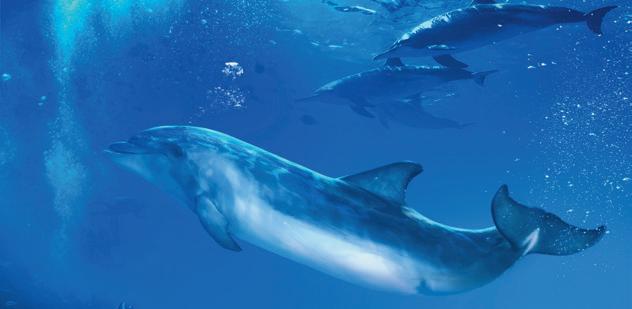
Benjamin Mkapa, Jakaya Kikwete, John Magufuli, … Clue: Tanzanian presidents
Klute Peak (3,953 metres), Mount Meru (4,562 metres), Mount Mawenzi (5,148 metres), … (5,895 metres)
Clue: Tallest Tanzanian mountains
Thomson’s gazelle, eland, zebra, …
Clue: animals in the Great Migration
Lake Rukwa, Lake Nyasa, Lake Tanganyika, … Clue: Tanzania’s largest lakes

Pemba white-eye, Pemba green pigeon, Pemba sunbird, …
Clue: Endemic Pemba birds
Taarab, Musiki wa Dansi, Bongo Fleva, …
Clue: Tanzanian musical genres from oldest to newest
Auric Air connects its passengers to gorilla trekking adventures in Rwanda's Volcanoes National Park via flights to the country's capital, Kigali. It is worth taking time to explore your stopover city. To reveal just some of its attraction we spoke to celebrated Burundi-Belgian chef John Goffin who has called Kigali home for over a decade. Along with his wife, Nathalie Bonte, he co-owns the restaurant Poivre Noir, which has become one of the leading lights on the capital's vibrant dining scene.




Which neighbourhood of Kigali do you live in and why did you choose it?
I currently live in Kicukiro in the southeast of the city. It is a quiet and relaxing neighbourhood. My family and I – John lives with his wife and two daughters – have moved quite a few times during our years in Kigali. We have stayed in Nyamirambo and Gikondo, for example, and I enjoyed the experience of living in each one of them.
What do you like most about living in Kigali?
It is an extremely clean city. The traffic is moderate, and you don’t need to travel long distances to find peace within the amazing nature and landscapes that surround the city. It’s also safe wherever you go in the city.
Where do you like to go to pick up the fresh ingredients for your cooking?
At the restaurant we collaborate with Pride Farms [a shop and delivery service offering fresh organic produce from farms across Rwanda] to source our products. They’re conscious and innovative approach to farming is what we’re looking for in order to provide the freshest and healthiest ingredients to our customers.
What is your favourite local delicacy?
I would say the fruits and avocados in general. I particularly enjoy the tamarillo fruit which is here called “ikinyomoro”. It has a subtle and citrus flavour, not very sweet. No two tamarillo have the same taste, they each taste different.
Rwanda is renowned for its coffee. Where is your favourite spot to enjoy a brew?
Rubia Coffee Roaster in Kimihurura. Their coffee is very good. It’s close to my workplace and I enjoy


sitting there from time to time to work on my laptop while sipping on a nice, warm cup.
I also love Question Coffee and their ‘lab’ approach to coffee making with different varieties and brewing techniques. I also like the social dimension and impact of their initiative on developing women’s empowerment in the coffee business.
Where do you go in the city if you want peace and quiet and time to reflect?
Exactly there…a coffee shop
What is your favourite view in the city?
I love the view of Kigali you get from the Ubumwe Grande Hotel’s rooftop. The display of those “thousand hills” is breathtaking.
Best place to hang out with friends for brunch?
Of course, I’d say my place…Poivre Noir! But I might be a little biased.
Where do you go for exercise in the city?
Soho Fitness in Kimihurura. It has an intimate, almost family-like vibe. The trainers are definitely dedicated at assisting and giving good advice. Plus, they have a nice garden café where, after exercising, you can enjoy a protein shake.
Where do you like to go out for an evening meal?
I enjoy many places. One of them is Repub lounge in Kimihurura. It’s vibrant, casual and friendly and the food is always good. It’s a great place to get a true flavour of East African food culture.
If I want something really special, it would have to be Meza Malonga – gastronomic African cuisine at its best.
If you are having a night out in Kigali, where are some of your favourite places to go?
In Kigali there’s always a new night spot to try out. It’s hard to keep track. Molato near the airport is one of the great spots to experience.
For someone who is new to the city, where would you recommend they go first to get a flavour of the real Kigali?
I’d say start by visiting Nyamirambo. Most say it’s the real Kigali. Whether you agree or not, it’s definitely one of its most vibrant neighbourhoods.
When you are away from Kigali, what do you miss most about it?
Bigger cities are usually quite bustling, which I enjoy, but at some point I will start missing the peace I can find in Kigali.
Poivre Noir is open Monday to Friday from 11am to 3pm and 6pm to 10pm and on Saturday from 11am to 10pm. Reservations are recommended to secure a table on the elegant terrace overlooking the city. Call +250 787 686 753 to book or visit @poivrenoirkigali on Instagram for more information and upcoming events.
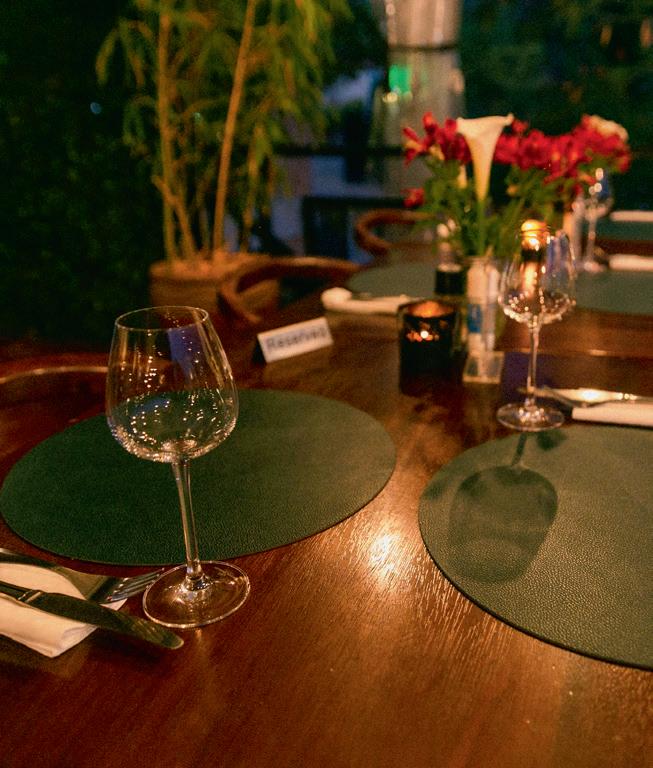
“We source local organic products in order to provide the freshest and healthiest ingredients to our customers”



Initially intended to be the capital of Tanzania in colonial times, Tanga is now on few travel itineraries, largely overlooked in favour of the headline-grabbing attractions of Arusha and Zanzibar to its northwest and south, respectively. However, it would be a pity to pass this Swahili Coast port town by as beyond its own attractions it is the gateway to some of Tanzania’s most exclusive beach and cultural adventures.
Founded in 1903, this is Tanzania’s first modern market – and it is still going strong today. Located in the city’s commercial centre, the covered market is packed with stalls laden with locally grown fruit and vegetables as well as spices while a fish market next door sells the catch of the day. The market is also a great place for souvenirs with a fantastic selection of local handicrafts such as woven bags, sculptures, jewellery and musical instruments. Taking time to browse here is a feast for the senses and an opportunity to soak up urban Tanzanian life in a friendly, relaxed way.
These extensive caves are considered the ‘jewel in Tanga’s crown’ and exploring them with a guide on a torch-lit tour is a true adventure. The limestone labyrinth located near Amboni village 8km northwest of Tanga is thought to have been around since the Jurassic age 150 million years ago and many locals hold the belief that the subterranean network still houses ancient spirits with supernatural powers. Some of the caves have been designated ‘mizimu’ or sacred sites where shrines have been set up to make offerings to the spirits. Your guide will show you some of them, including one believed to house

a powerful deity that can alleviate sickness, suffering and increase fertility. You’ll also get to see the sculptural stalagmites and stalactites that have formed over centuries from mineral deposits in the caves. The tour focuses on a small section of the caves. Just how far the rest extends has long been the subject of local legend with the caves originally thought to reach all the way into Kenya and there’s plenty of cautionary tales about people entering never to be seen again. Better hold on tight to your guide!
Tanga became a key military post in German East Africa in the years leading up to the First World War and there are many colonial buildings in the city that have survived from that time. Most are in a state of faded grandeur, but the former Old Boma [small fort] has been renovated and now houses the Urithi Tanga Museum. Here you’ll find plenty of historical photos and artefacts from the area to document the city’s storied history. Staff are knowledgeable and there are regular tours to reveal the stories behind the exhibits. For example, did you know the District Official of Tanga under German rule Paul Ilaire was a keen botanist who discovered the first African Violet in the cloud forest of the Usambara Mountains. Subsequent cross breeding has made the beautiful blue flower popular across the world.
This recently declared park was set up to protect a 100km stretch of coastline north of Tanga City known for its local population of prehistoric coelacanth (pronounced see-lah-canth) fish. This massive deep-sea creature – adults can grow up to two metres in length and weigh in at 90kg – was thought to have been extinct for around 60 million years with only fossils surviving to tell of its former existence. However, scientists have been shocked to find it alive and well off the coast of East Africa, turning up in fishing nets off Tanga, Malindi in Kenya and the Comoros Islands. Clues to why this prehistoric creature has survived in the Tanga waters come from the sharp slopes and steps in the reefs here which contain caves at a depth of 150 metres. In these cool waters the coelacanth
“Both the tombs and mosque date back to the 14th or 15th century”


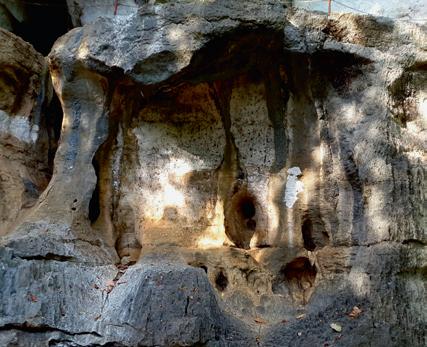
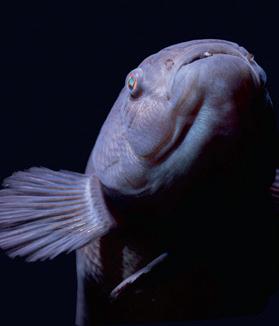


drift feeds on smaller fish, eels and cuttlefish. It steers with paddle-like fins scientists believe represent an early step in the evolution of fish to terrestrial four-legged animals like amphibians. The Tanga park has a record of harbouring bizarre marine creatures with its waters also home to the endangered dugong, with its whale-like fluked tail, although sightings are now increasingly rare. You’ll also find sea turtles and hundreds of species of fish so the diving opportunities here are not to be missed.
In the 19th century, Pangani, 55km south of Tanga, was a prominent port for Indian Ocean trading and the starting point for many European missionary expeditions. That cosmopolitan bustle is long gone with just a few crumbling architectural remnants such as the Old Boma still standing. What remains is a sleepy village and some of the most spectacularly beautiful beaches in Tanzania. The pristine coastline is hemmed by palm trees and mangrove forests while green turtles nest in the untouched sands. Off-shore there are islands ringed by coral reefs that provide wonderful opportunities for snorkelling and scuba diving. Visitors can take a boat to Maziwe Marine Park Island to swim, sun-bathe, snorkel and maybe spot a pod of dolphins. Boat trips are also available on the massive Pangani River, which collects its water from Mt Kilimanjaro and Meru before emptying into the Indian Ocean.
Nearby Pangani you’ll also find the tiny fishing village of Tongoni and its fascinating collection of crumbling ancient tombs overlooking the ocean. Among the ruins is the remains of a mosque and around 20 tombs, the largest collection of their kind in East Africa. Both the tombs and mosque date back to the 14th or 15th century, a time when Tongoni was a thriving Swahili trading centre whose visitors included Portuguese explorer Vasco de Gama – albeit inadvertently, his ship ran aground there – was much taken with the quality of oranges grown here, professing them far superior to the ones at home.
If your home was the green and serene Pemba, why would you want to migrate?
The island’s plentiful bird life includes five species not found anywhere else in the world. With the help of local guide Hamad Kombo, we learn more about these unique birds and their connection to the island’s ecosystem.

What is it?
With full-grown adult measuring around 18cm in length, the Pemba Scops-owl is one of the smallest scops-owls in the world. The population is estimated to be between 1,500 and 4,500 breeding pairs.
Distinguishing features:
They have very short ear tufts, but they do prick up and become more noticeable when the owl is on alert. Their plumage is mostly brown but there are varieties with a more reddish hue to their feathers. Their colouring means they are well camouflaged within their woodland habitat, but your eye might be drawn to their yellow eyes and legs. Otherwise, you can listen out for their distinctive mournful hoot at night.
When and where to find it:
Kombo says: “Like most owls, this bird is nocturnal. Daylight hours are spent roosting in dense wooded habitats such as the island’s tropical Ngezi Forest or in overgrown plantations. When night falls it flies off to hunt for insects, seek mates or engage in other owl behaviour.”
Did you know?

The lush, double canopy Ngezi Forest is one of the last remaining areas of indigenous forest that once covered much of the island. A forest reserve was set up to protect what is left, but the owl’s dwindling habitat has caused its numbers to decline.
What is it?
A small, sharp-billed warbler-like bird that inhabits dry or moist forests, bushlands, thickets and dry savannah.
Distinguishing features:
As their name implies, they have a conspicuous ring of tiny white feathers around their eyes as if they were wearing spectacles. Its feathers are bright yellow with greyer shades across the wings.
When and where to find it:
Kombo says: “Pemba White Eye flit through the air in noisy flocks all over the island so spotting them shouldn’t be an issue. They are very vocal. Listen out for their high-pitched, cheerful series of whistled notes.”
Did you know?
They feed mainly on insects, but also soft fleshy flowers, nectar, fruit and small grains.


What is it?
This fruit-loving pigeon sticks to the feeding grounds offered by the island’s dense forests and farms. As a frugivorous bird, it plays a significant role in seed dispersal. The seeds of the fruit the bird consumes pass through its digestive system, enabling the dispersal of these seeds across the forest, helping to maintain the biodiversity and overall health of the forest ecosystem.
Distinguishing features:
The Pemba Green Pigeon is renowned for its for its resplendent green plumage and its purring call.
When and where to find it:
Kombo says: “The Pemba Green Pigeon is found in forest, the forest edge, plantations, and villages, often around fruiting trees. Look out for betel palm trees in the forest as their fruit – which look like tiny apricots when ripe – is the bird’s favourite.”
Did you know?
Pemba Green Pigeons are monogamous and spent their life with that partner. When you see them on the island it will mostly be as a loved-up couple.
What is it?
A colourful, nectar-feeding bird. Its iridescent feathers and relaxing call will soon become familiar to you on the island.
Distinguishing features:
The male of the species lives up to its name with iridescent feathers that reflects vivid blues, greens and purples. The females are grey-brown on their head and wings with a pale yellow underside with blurry streaking and a small pale yellow lateral streak at the back of the head. You may also notice one of their distinctive purse-shaped nests tightly bound with spiders’ webs and hanging from a tree branch.
When and where to find it:
Kombo says: “The population of sunbirds is spread out across the whole island. In every habitat you will see them shining out.”
Did you know?
The sunbird’s thin, downward curved bill allows them to dip into flowers to sip nectar using a long, tubular tongue. They are important pollinators for plants on Pemba. The sunbirds also eat fruit, small insects and spiders.

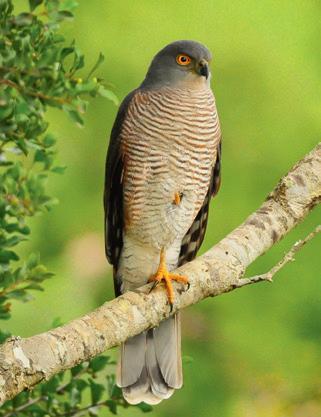
What is it?
This bird of prey is a recently discovered variety of African goshawk endemic to Pemba.
Distinguishing features:
Its broad wings – almost twice the length of body – and elongated tail should identify this majestic bird. Females are larger and have paler feathers in contrast the male’s darker grey plumage.
When and where to find it:
Kombo says: “The Pemba goshawk generally sticks to the island’s forest and diverse dense woodland.”
Did you know?
Thanks to its broad wings, the goshawk can hunt at high speed, weaving effortlessly in and out of trees, while its legs and talons can catch its prey – usually small mammals and lizards – in flight.
To book a birding tour in Pemba with Kombo, call +255 776 428 427 or email kombohamad424@gmail.com

The volcanic landscapes of Ngorongoro made Tanzania the first sub-Saharan African country to contain a Unesco Global Geopark. The jewel of the Arusha region is also one of the continent’s most famous safari destinations and holds links to our earliest human ancestors



“The area is rich in cultural sites often linked to local traditional rituals, such as the Datoga graves”

Since the Ngorongoro Conversation Area was endorsed by the United Nations as the Ngorongoro Lengai UNESCO Global Geopark in 2018, its stand-out attractions such as Olduvai Gorge, Ngorongoro Crater and Lake Natron are being primed for tourists to add to their itineraries on the way to Northern Circuit big-hitters such as the Serengeti National Park.
Unesco and the Ngorongoro Conservation Area Authority (NCAA), which will manage the geopark, are also keen that the benefits extend to the 230,000 human inhabitants who call the region their home.
The geopark lies just south of Lake Natron in the Rift Valley, in the heart of Maasai country. For the Maasai the region is a sacred place. The park takes its name from two of its most striking sights – the Ngorongoro Crater and the active volcano Oldoinyo Lengai –which mean ‘Gift of Life’ and ‘Mountain of God’ respectively in the Maasai language. The tribe keeps vigil over the region’s wonders while herding cattle on its endless grasslands.
The NCAA is keen to encourage the role of the Maasai as guardians of the geopark and to involve them in decisions on sustainability and conserving these areas of geological heritage. This extends to other resident several ethnic groups, mainly Irawq, Datoga and Hadzabe.
The area is rich in cultural sites often linked to local traditional rituals, such as the Datoga graves, which are an important pilgrimage site for the Datoga tribe. These graves belonged to a spiritual leader Gitangda and his son who died more than 150 years ago while defending their land against the Maasai in Ngorongoro.
They are also a big part of the growing experiential tourism sector, with these land-linked communities in the region giving visitors a taste of authentic Africa. They act as expert guides, sell their intricate jewellery and welcome guests to their settlements.
Any visitor will understand why the Maasai so venerate the region covered by the geopark. It is twice the size of the already established Ngorongoro Conservation World Heritage Site, stretching to the Serengeti National Park in the north, Lake Natron
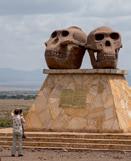
to the east, the Great Rift Valley to the south and Maswa Game Reserve to the west and is packed with awe-inspiring features.
Among them, as previously mentioned, is Oldonyo Lengai, Tanzania’s third-highest peak and its only active volcano. When it erupts, it is the only volcano in the world to produce an almost silicone-free natro-carbonatite lava that can appear black in sunlight rather than the glowing red of usual eruptions.
Guided treks of Oldoinyo Lengai and some of the other highest peaks in the region, such as Mount Lolmalasin, are a true adventure.
The Olduvai Gorge, a steep-sided ravine in the Rift Valley, is one of the most famous palaeontological sites in the world. Its exposed volcanic beds were formed up to 2.6 million years ago and have yielded fossils of early man as well as Middle and Late Stone Age artefacts.
Just 45 km south of the gorge is Laetoli, another key palaeontological site. It was here that the
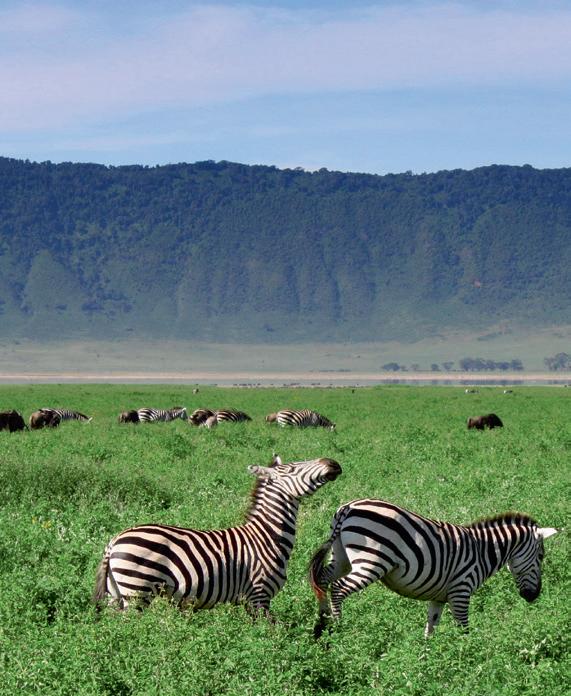
earliest traces of mankind were found in a set of footprints 3.6 million years old and preserved in volcanic ash.
The Ngorongoro Crater was caused three million years ago by a super volcano erupting with a blast so ferocious that it caved in on itself. Over the next millennia the resulting caldera caught rainwater and lush vegetation developed and then came the animals – lots of them. Now the walls of the caldera form a natural colosseum to harbour a huge diversity of wildlife species such as elephant, black rhino, lion, gazelle, and other large mammals (not giraffe – their gangly limbs are unable to navigate the crater walls).
More great wildlife spotting is to be had at Lake Natron. The soda lake’s 120-degree waters make it inhospitable to most, but lesser flamingos love the algae it produces and flock there in their millions. An incredible sight.
These attractions already have a considerable touristic cachet in Tanzania, but the size of the Unesco Geopark means many more worthy attractions within its boundaries will benefit by association.
Among the huge list are the Empakai and Olmoti craters, Maasai manyattas, the River Munge, the elephant caves of Karatu, the Olkarien Gorge, Nasera Rock, the Eyasi warm water spring, Lerai Forest and the Leakey Museum.
For more information on the work of the NCAA and questions on tourism or scientific study in the geopark, email cn@ncaa.go.tz

You may have seen the popular board game ‘bao’ being played by locals on your travels in East Africa, but Ngorongoro takes it to another level. Usually a small hand-carved board with four rows of ‘pits’ is used for each player to place their seed counters on and move towards ‘home’. Here, though, a wooden board is replaced with holes in the earth especially on the hard exposures found in crater floors and on top or around small hills around the area. At these local ‘bao sites’ players use small, round stones to play the game. It’s an easy game to start and a tricky one to master. Playing here with the locals will be unforgettable.
Your gateway to East Africa
With their short take-off and landing capabilities‚ the 20-strong Auric Air fleet opens up a world of possibilities for reaching destinations that are inaccessible to larger aircraft. Here’s a closer look at our built-for-adventure fleet.

Cessna Grand Caravan C208B EX
NUMBER OF AIRCRAFT IN FLEET: 13
MAXIMUM RANGE: 912 NM
MAXIMUM CRUISE SPEED: 185 KTAS
MAX OCCUPANTS: 10 TO 14
Grand Caravan C208B
NUMBER OF AIRCRAFT IN FLEET: 4
MAXIMUM RANGE: 1,070 NM
MAXIMUM CRUISE SPEED: 186 KTAS
MAX OCCUPANTS: 13 WITH ONE PILOT OR 12 WITH TWO PILOTS
ONBOARD EXPERIENCE:
A fleet which is among the youngest of Caravan fleets in this region. This type of all-weather aircraft has been chosen to meet the specific requirements of operating into bush airstrips and more remote landing areas in East Africa.

NUMBER OF AIRCRAFT IN FLEET: 2
MAXIMUM RANGE: 1,148 NM
MAXIMUM CRUISE SPEED: 270 KNOTS
MAX OCCUPANTS: 39
ONBOARD EXPERIENCE:
Step aboard our Dash 8 aircraft and experience a new level of comfort. The spacious cabin design‚ plush seating‚ and ample legroom guarantee a relaxing and enjoyable flight. Whether you're embarking on a short-haul journey or exploring remote destinations‚ the Dash 8s quiet operation and smooth flying experience will exceed your expectations.

NUMBER OF AIRCRAFT IN FLEET: 1
MAXIMUM RANGE: 1,137 NM
MAXIMUM CRUISE SPEED: 280 KNOTS
MAX PASSENGERS: 9 (ONE PILOT), 8 (TWO PILOTS) SIX EXECUTIVE SEATS
ONBOARD EXPERIENCE:
The latest addition to the Auric Air fleet has a powerful PT67A-67P engine renowned for its performance, quiet running and high maximum cruise speed. It also burns up 65 per cent less fuel than comparable jets. Used primarily for private charters, its spacious interior includes executive seats featuring full recline and plenty of seated headroom. The PC-12 has gained a reputation for versatility, performance, reliability and operational flexibility.
Our entire fleet is meticulously maintained by Hawk Aviation Ltd‚ a reputable organisation head-quartered at Wilson Airport, Nairobi. With approvals from the Kenya Civil Aviation Authority‚ the Tanzania Civil Aviation Authority‚ and the Uganda Civil Aviation Authority‚ Hawk Aviation ensures the highest
standards of safety and reliability. All Hawk Aviation engineers in charge of maintaining the aircraft are appropriately licensed having attended approved aircraft type-rating courses with considerable practical experience ensuring all aircraft are looked after by the best of personnel.
Packing light for a safari is a must, but don’t panic. Here’s our guide to the essentials that will ensure you are kitted out for all that comes your way but won’t take you over the 20kg limit for your (soft-sided, please) baggage.



Clothes
Your camp or lodge is very likely to have a laundry service with a 24-hour turnaround so you can survive on a capsule collec tion of clothes and keep refreshing them. The heat and the dust of the savannah means you will get dirty and as you came to observe the wildlife, rather than being mistaken for the wildlife, make the lodge’s laundry staff your friends during the trip.

As for what to wear, think light layers. You’ll want moisture wicking T-shirts, shorts and light trousers for the heat of the day, but also a fleece and a scarf (or pashmina) for early starts or a night safari when you’ll feel the chill.
While you may want to stand out from the khaki crowd and wear some brighter colours, just remember that you will also be making yourself a mosquito magnet and more visible to certain wildlife, which may encourage them to keep their distance.
Wearing earthy tones such as khaki, brown and olive will help you to blend in with the environment and hide dust and dirt. Add some trainers or boots with a decent tread (most safaris don’t require you to have serious hiking boots) and a wide-brimmed hat to protect your skin from the plentiful sunshine.
Again, your lodge will most likely be providing each guest with shampoo/conditioner and body wash (often organic and locally made), but you will need to bring a high-factor sunscreen and moisturiser to guard against sun damage, along with a can of bug spray – a Deet-based product should ward off mosquitoes and tsetse flies. Any self-respecting safari company will have a fully stocked first-aid kit in its vehicle, but it doesn’t hurt to carry your own small pack. Lip salve and hand sanitiser come in space-saving small sizes, and both will come in handy.
However light you are packing, make sure there is room for a pair of binoculars (although most safari vehicles have a pair). Not only will they bring Tanzania’s incredible wildlife closer to you, but they will also allow you to observe some of the country’s more dangerous inhabitants – big cats, buffalo, hippos and crocs – from a safe distance. Go for a magnification of between 8 and 10 so animals will look eight or ten times closer to you than they actually are. If you go too much higher, the image may get blurry, especially if you are bouncing around in a safari vehicle.
Big lenses, heavy cameras and awkward tripods can fill your bags pretty quickly. They are an essential part of a safari, though, allowing you to capture those magical memo ries of your trip forever. If you are looking to take images that will in the future be framed and grace your walls at home, all the packing is probably worth it. However, at the risk of upsetting the purists, it is amazing the quality of pictures you can take on the average smart phone these days.

Tech such as mobile phones and cameras will require frequent charging and the energy source you can be sure of in Africa is solar. For your convenience and for the good of the environment, consider a good solar charger.
We wish you all happy travels and if you have taken some pictures of a memorable safari after flying with Auric Air, Explorer would love you to send them on to us so we can share them with our readers. Email your images to markedwards@landmarine.com SHARE YOUR PHOTOGRAPHS
One of the many wonderful aspects of escaping into the remote wilds of Tanzania, especially for a visitor used to urban environments, is the lack of light pollution. It makes for star-filled night skies that take your breath away, but it can get pretty dark so a flashlight could come in useful if you are finding your way back to your tent or lodge – even when ranger accompanied.
Travelling light does not begin and end with your baggage. At Auric Air, we always try to leave as light a footprint as possible wherever we travel across Tanzania, so it is just as glorious for the next person to travel.
Our 15-strong network of destinations connects with some of the most remote and unforgettable attractions across Tanzania and beyond. Here’s where we fly.
What began as a humble fishing village is now the biggest and busiest city in Tanzania. Dar es Salaam is where you can experience the fusion of the Swahili culture and modern life. The culturally diverse city has a vibrant community with thriving food, music and art scenes. Here you can get a hit of city life and a toes-in-the-sand slice of the beach all in one.
The Ugandan city on the shores of Lake Victoria is the gateway to a host of primate adventures such as mountain gorilla trekking in Bwindi National Park and boat rides to Ngamba Island Chimpanzee Sanctuary, which protects orphaned chimps
Time spent in this tranquil town in the southern highlands of Tanzania reveals a rich historical background – battles were fought here during German colonial times and the world wars – as well as insight into traditional African culture. It can also be the base for safari adventures with Ruaha National Park close by.

More gorilla adventures can be pursued in Rwanda. The country’s capital, Rwanda, is one of Africa’s most progressive cities as well as being the launch pad for trips to Volcanoes National Park where wild gorillas live among the high forest of the Virunga Mountains – a dramatic backdrop for the trekking experience.
The beautiful, bijou Lake Manyara National Park is dominated by its titular soda lake that takes up almost two thirds of the park during the wet seasons and attracts vast flocks of flamingo, pelican and more than 130 more species of birds. It comprises a diverse range of habitats with herds of elephant, giraffe, baboons and impala roaming the grass and woodland while its forests contain all manner of monkeys as well as tree-climbing lions.
A trip to Tanzania’s deepest lake opens up the country’s remote west. Here you can dive or snorkel to explore the lake’s unique marine life or take longer


canoe and trekking adventures into the Mahali Mountains, renowned for its wild chimpanzees.
The waters surrounding the Mafia archipelago are protected so its pristine reefs teem with marine life and offer some of the best diving experiences in East Africa. Giants of the sea such as whale sharks and humpback whales are also regulars here.
This protected reserve in southern Kenya is one of the best places in the world to observe animals in the wild. Its sprawling plains are home to the Big Five‚ there are hippos and crocodiles in the rivers‚ and more than 500 species of birds. The reserve is particularly famous for its big cats—lions‚ leopards‚ and cheetahs. While the wildlife viewing at almost any time of the year is superb‚ the Masai Mara is best visited during the months of the Great Migration‚ when millions of zebra‚ wildebeest‚ and gazelle make their way


north into the park from the Serengeti‚ crossing the Mara River in search of fresh grazing.
Nyerere National Park is Tanzania’s newest and now largest national park, yet tucked away in the country’s southern wilderness it is something of a hidden gem. Its rivers and lakes are the lifeblood of the park that hosts some fabulous game‚ including elephants‚ wild dogs‚ buffalo‚ hippo‚ crocodiles‚ and fantastic prides of lions.
Pemba is the second-largest island of the Zanzibar archipelago and provides a
Your gateway to East Africa
WhatsApp: +255 783 233334
+255 746 986123
auric@auricair.com www.auricair.com
lush, lowkey alternative to its larger neighbour, Unguja. Nicknamed ‘The Green Island’, Pemba is renowned for its fertile soil with its clove and vanilla plantations securing it global trading renown. Ringed with pristine beaches and reefs and with a forested interior that is home to endemic birds and mammals, Pemba is a haven for nature lovers.
This massive national park is ideal if you want to escape the crowds. Here you can enjoy outstanding levels of wildlife – some of the country’s largest prides of lions and herds of elephants call Ruaha home – with almost no other vehicles around.

This island in the southwest corner of Lake Victoria has national park status with colobus monkeys, elephants, giraffes, hippos and crocodiles enjoying its sanctuary. As well as its animal adventures, the island is a true wild getaway with deserted beaches and virgin forest to explore.
With access to the hot-spots of the Great Migration and some of the largest concentrations of African wildlife –including more wild lions than anywhere else in the world, the Serengeti takes safaris to another level. The park welcomes almost a hundred thousand tourists every year.
In colonial times, this port city in northern Tanzania headed East Africa’s trade links with the world. Now it has a more sleepy, laidback appeal, offering charming insights into the Swahili lifestyle. It also provides access to the East Usambara Mountains and the beaches of Pangani.
Zanzibar’s main island, Unguja, has become one of Africa’s most popular tourist attractions. Resorts pepper its spectacular beaches while its historic centre, Stone Town, is a living museum of its trading heyday as well as vibrant proof of the cosmopolitan Swahili culture with its exciting food, music and arts scenes.
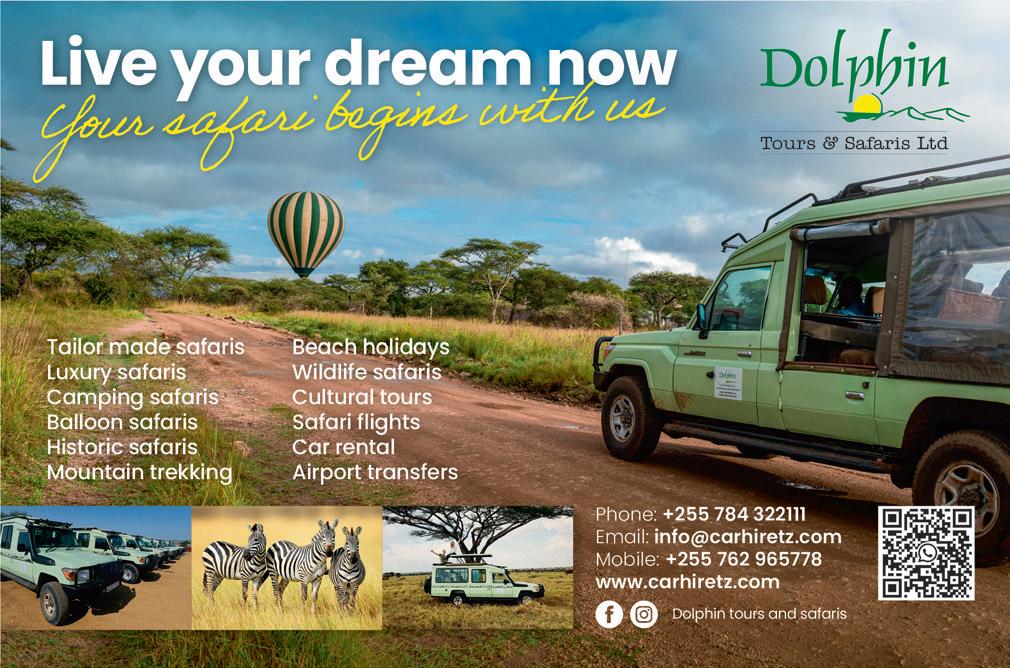


Auric Air chatbot is available to answer your questions 24 hours a day, 365 days a year. Scan the code or Whatsapp "Hello" to +255 783 233334 to get started.

Auric Air chatbot is available to answer your questions 24 hours a day, 365 days a year. Scan the code or Whatsapp “Hello” to +255 783 233334 to get started.
Everything you need to know to get your journey with us off to a smooth start.

Baggage allowance for each passenger is 20kg (inclusive of hand baggage‚ cameras‚ filming equipment and any other personal item including loose clothing). Hard suitcases are allowed, but the dimension of individual items of luggage should not exceed dimension of 90cm in length, 65cm in width and 35cm in depth.
If passengers anticipate they will have excess baggage‚ excess baggage is bookable in advance in slabs of 10kgs. The excess baggage cost is between US$ 30 and US$ 60 depending on destination.
A maximum of four slabs (40kgs) additional luggage can be booked per person. For more than 40kgs‚ a freight seat at child fare is to be booked‚ which will permit a carriage of an extra 75kgs
There is a complimentary secure store at our Dar es Salaam airport office. Please enquire in advance.
You can make payment online by credit card or mobile money at the time of making your booking. Alternatively‚ email reservations@auricair.com for other payment options such as credit card payment links or bank transfer options.
Children aged between two and 11 years (inclusive) are charged 75 per cent of the applicable adult fare. Infants under two years of age are not charged providing they are not occupying a seat. Infants are not entitled to baggage allowance.
No-show passengers will be required to book and pay for new tickets. If prior

notification is received by up to 24 hours before the flight‚ Auric Air can transfer your booking‚ at a cost of 50 per cent of your ticket basic cost‚ to the next available flight but has no responsibility whatsoever for any related extra costs. If seats are not available‚ no refunds will be made. You are advised to ensure that your travel insurance covers such situations. Details of any amendment or a cancellation must be sent by email to reservations@auricair.com
The latest Check-in time for all passengers is strictly 60 minutes before flight time. Auric Air reserves the right to depart up to 15 minutes ahead of the scheduled departure time if passengers are not present at the place of departure by that time. Auric Air has no responsibility for direct or indirect costs resulting from passengers missing a flight due to non-compliance‚ for whatever reason‚ with the above check-in times.
Auric Air operates from Terminal 1 at Julius Nyerere International Airport in Dar es Salaam.
A woman with an uncomplicated pregnancy and clearance from their doctor can board flights up to the end of the 30th week of pregnancy. A doctor’s certificate or clinical card must be provided and Part 1 of our MEDI form must be completed by the passenger. They then have to be seated on the last single seat near to the emergency door.

